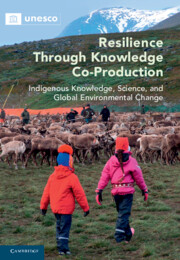 Resilience through Knowledge Co-Production
Resilience through Knowledge Co-Production Book contents
- Resilience through Knowledge Co-production
- Resilience through Knowledge Co-production
- Copyright page
- Contents
- Contributors
- Acknowledgements
- Introduction
- Part I From Practice to Principles
- Part II Indigenous Perspectives on Environmental Change
- Part III Global Change and Indigenous Responses
- 12 Competing Paradigms of Himalayan Climate Change and Adaptations: Indigenous Knowledge versus Economics
- 13 Coping with a Warming Winter Climate in Arctic Russia: Patterns of Extreme Weather Affecting Nenets Reindeer Nomadism
- 14 Rising Above the Flood: Modifications in Agricultural Practices and Livelihood Systems in Central Amazonia – Perspectives from Ribeirinho and Indigenous Communities
- 15 Indigenous Storytelling and Climate Change Adaptation
- 16 Indigenous Knowledge and the Coloniality of Reality: Climate Change Otherwise in the Bolivian Andes
- Epilogue
- Index
- References
14 - Rising Above the Flood: Modifications in Agricultural Practices and Livelihood Systems in Central Amazonia – Perspectives from Ribeirinho and Indigenous Communities
from Part III - Global Change and Indigenous Responses
Published online by Cambridge University Press: 02 June 2022
- Resilience through Knowledge Co-production
- Resilience through Knowledge Co-production
- Copyright page
- Contents
- Contributors
- Acknowledgements
- Introduction
- Part I From Practice to Principles
- Part II Indigenous Perspectives on Environmental Change
- Part III Global Change and Indigenous Responses
- 12 Competing Paradigms of Himalayan Climate Change and Adaptations: Indigenous Knowledge versus Economics
- 13 Coping with a Warming Winter Climate in Arctic Russia: Patterns of Extreme Weather Affecting Nenets Reindeer Nomadism
- 14 Rising Above the Flood: Modifications in Agricultural Practices and Livelihood Systems in Central Amazonia – Perspectives from Ribeirinho and Indigenous Communities
- 15 Indigenous Storytelling and Climate Change Adaptation
- 16 Indigenous Knowledge and the Coloniality of Reality: Climate Change Otherwise in the Bolivian Andes
- Epilogue
- Index
- References
Summary
The objective of this chapter is to describe the ways in which traditional (ribeirinho) and Indigenous (Cocama) farmers of Central Amazonia are modifying their agricultural and livelihood practices in response to extreme flood events, linked to global climate change, which have occurred over the last ten years. Data were gathered through observation and semi-structured interviews conducted by researchers and technicians of the Mamirauá Institute for Sustainable Development, Brazil. Farmers from upland and floodplain environments agree that large floods are more frequent in the region. Extreme floods have resulted in the disappearance of farmers’ local varieties of manioc and diverse fruit species. Residents also discuss the social consequences of floods, including cyclical migration of families between upland and lowland areas and a deteriorating quality of community life during floods. While our initial results demonstrate farmers’ abilities to adapt in the face of rapid global change, we continue to try to understand the processes of ongoing social, economic and environmental change and the extent and limits of local adaptive capacity.
- Type
- Chapter
- Information
- Resilience through Knowledge Co-ProductionIndigenous Knowledge, Science, and Global Environmental Change, pp. 233 - 246Publisher: Cambridge University PressPrint publication year: 2022
References
- 1
- Cited by


